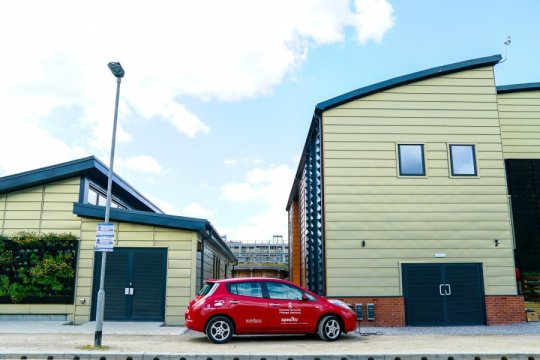[ad_1]
The UK’s first energy-positive classroom, designed with research expertise from Swansea University, generated more than one and a half times the energy it consumed, according to data from its first year of operation, the team has revealed.
The findings were announced as the researchers launched the next phase of their research, gathering data and evidence on an office building, constructed using similar methods.
Buildings currently account for around 40% of UK energy consumption. This new building, known as the Active Office, points the way to a new generation of low-carbon offices which produce their own supply of clean energy.
It was designed by SPECIFIC, a UK Innovation and Knowledge Centre led by Swansea University.
Professor Dave Worsley, Research Director for SPECIFIC and Swansea University College of Engineering, explained how the work of SPECIFIC involves a two-way link between research and real-world application:
‘SPECIFIC’s research focuses on developing solar technologies and the processing techniques that take them from the lab to full-scale buildings.
With our building demonstration programme we are testing and proving the ‘buildings as power stations’ concept in real buildings, which are used every day. The data obtained from these buildings is then fed back into our fundamental research into solar energy technologies and used to accelerate and steer their development.’
The Active Office combines a range of innovative technologies that will enable it to generate, store and release solar energy in one integrated system, including:
- A curved roof with integrated solar cells — showing the flexible nature of the laminated photovoltaic panel;
- A Photovoltaic Thermal system on the south facing wall — which is capable of generating both heat and electricity from the sun in one system
- Lithium ion batteries to store the electricity generated and a 2,000 litre water tank to store solar heat
The ‘buildings as power stations’ concept has already been shown to work. Right next to the Active Office is the Active Classroom, the UK’s first energy-positive classroom. Also built by SPECIFIC, this was recently named Project of the Year by the RICS Wales. In its first year of operation, the Active Classroom generated more than one and half times the energy it consumed.
The Active Office and Classroom will be linked together and able to share energy with each other and electric vehicles, demonstrating how the concept could be applied in an energy-resilient solar-powered community.
They will provide functional teaching and office spaces, as well as building-scale development facilities for SPECIFIC and its industry partners.
Energy positive buildings could benefit the UK significantly. A 2017 analysis showed that it would mean:
- Lower energy costs for the consumer
- Less need for peak central power generating capacity and associated reduction in stress on the National Grid, leading to improved energy security
- Reduced carbon emissions
The Active Office has been designed to be easy to reproduce. It is quick to build, taking only one week to assemble, with much of the construction taking place off site. It also uses only technologies that are commercially available now, which means there is no reason why they could not be used on any new building.
Kevin Bygate, chief operating officer of SPECIFIC, said:
“Offices are enormous consumers of energy, so turning them energy-positive has the potential to slash fuel bills and dramatically reduce their carbon emissions.
Turning our buildings into power stations is a concept that works, as the Active Classroom shows. This new building will enable us to get data and evidence on how it can be applied to an office, helping us refine the design further.
The Active Office is a first, but it isn’t a one-off. It is quick to build using existing supply chains, and uses only materials that are already available. This is tomorrow’s office, but it can be built today.”
Ian Campbell, Executive Chair of Innovate UK, said:
“It’s difficult to overstate the potential of developing a building that powers itself. The concept could genuinely revolutionise not only the construction sector but completely change how we create and use energy, so the opening of the Active Office in Swansea is an exciting step forward.
Developing technologies like those demonstrated in the SPECIFIC Active Office can play a strong role in the Government’s modern industrial strategy to create ‘clean growth’ and fulfil our mission to halve the emissions of new buildings by 2030.”
Alun Cairns, Secretary of State for Wales, said:
“The Active Office is a living example of how a building can make a difference to us and our environment using innovative technologies -and equally importantly creating jobs in Wales.
“Research and innovation has a proven track record to stimulate our economy. The UK Government has been a proud supporter of the project, and last year awarded £800,000 of funding towards it via Innovate UK.
“The UK Government is ambitious for Swansea, and the Swansea Bay City Region deal is expected to deliver more than 9,000 jobs and £1.3billion of investment across the region.
“I have no doubt that I’ll be back to Swansea University in the near future because of the great strides they are taking in the science and research field which are being recognised around the world.”
The Active Office was funded by Innovate UK, with support from Swansea University and the European Regional Development Fund through the Welsh Government, and is sponsored by Tata Steel and Cisco.
[ad_2]















